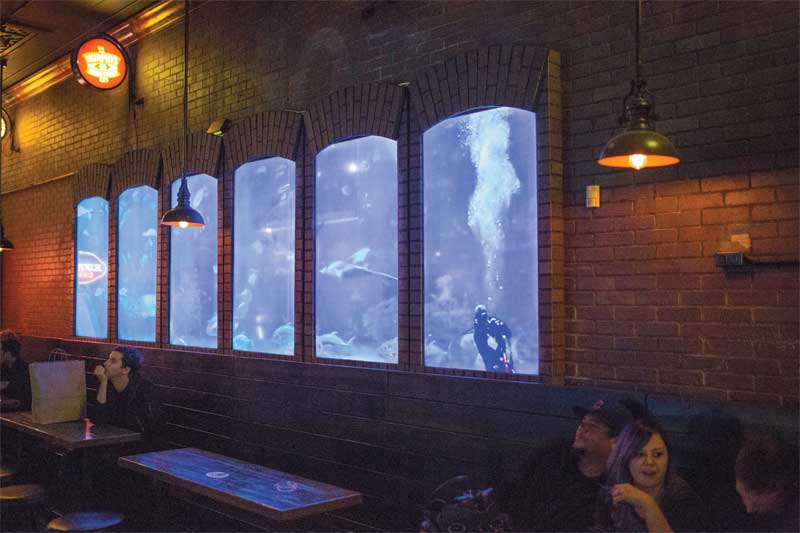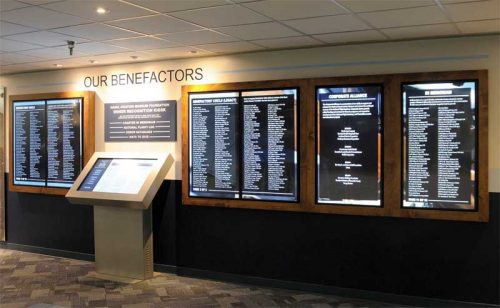Transforming spaces with video walls
by | 23 October 2020 10:23 am
By John Marshall
 [1]
[1]This installation at a Smokin’ Joe’s pub in Florida shows the innovative use of digital displays.
In industries ranging from healthcare to hospitality, video is the communication medium of choice and visual displays are the infrastructure of choice to maximize the impact of video, whether the content is a corporate video in a company’s lobby to impress visitors, or an overview of a complicated medical procedure to help surgeons save a patient’s life.
Companies, healthcare systems, government agencies, hospitality organizations, and many other industries have recognized the potential of video walls. MarketsAndMarkets, a research organization, forecast spending on video walls will jump from $4.12 billion in 2013 to $18 billion by 2020, a compounded annual growth rate (CAGR) of more than 23 per cent.
Because video walls represent an investment in time, budget, and resources, it is important the configuration and content of video walls fit specific needs of the organization. Some of those needs will be very concrete, such as first responders monitoring their facilities, organizations monitoring their company’s performance and operations, or perhaps more artistic, such as brightening up a lobby with a video wall filled with bucolic photos and videos.
Four fabulous applications for video walls
High bandwidth availability and more affordable network equipment have made it possible to leverage the use of higher quality videos and images to engage audiences. From there, video walls and multi-purpose visual displays have become an attractive alternative for a wider range of applications than ever before. Visual displays generally fall into one of a few categories: lobbies, to reinforce an organization’s brand; dashboard visualization, to manage key performance indicators (KPIs); and collaborative environments, such as conference rooms. The following are four innovative applications along with their role throughout a specific organization.
- Retail reality
There is a significant amount of research undertaken when retail store managers organize products on the shelf and where they are located in store. Given the profit margin of a typical supermarket, for example, hovers around one per cent, optimizing the store layout can mean the difference between profit and loss.
On the other hand, retail stores can leverage the use of video walls and displays to direct foot traffic to specific areas with certain products, to increase their profits. Chain stores can replicate the same model, and ensure maximum profit, across all their stores. (Hint: a centrally managed solution significantly simplifies this approach, especially when updating content simultaneously across all the video walls).
- Burgers and beer underwater
Bars and restaurants are continuously challenged by how to keep current patrons coming back, attracting new customers and keeping people in their establishments longer.
Creative video walls are an important solution to help bars and restaurants thrive. They offer a compelling atmosphere and can spark no end of conversations.
 [2]
[2]A video wall was used to enhance the entrance to Brazil’s retail giant Riachuelo’s flagship store.
3. Immediate gratification
Museums, theatres, symphonies, and many other non-profit organizations survive based on the generosity of their benefactors. In even a modest-sized organization, there are constant additions and changes to boards of directors, donors, and other supporters.
Video walls enable non-profit organization managers to quickly and easily update their lists of benefactors. When a donor makes a commitment on a Monday and sees his/her name on the list of benefactors at Saturday’s performance, it demonstrates the non-profit is well-run and well-organized, reinforcing the new donor’s decision to commit.
- Brand reinforcement
Organizations of all types must continuously reinforce their brand and value proposition. Artistic deployment of video walls enables marketing teams to quickly and effectively communicate their company’s offerings, differentiation, and competitive advantage, whether deployed in a corporate lobby, trade show exhibit, or related venue.
Strategies to create a successful video display
To maximize the return on investment (ROI) of a video wall and to avoid unpleasant surprises, such as cost overruns, it pays to strategize and plan in advance. Among the many factors organizations must consider are these five:
- Core architecture
Today, many displays have daisy-chaining capabilities, and can easily connect to each other and display content, although somewhat limited (and not very cost effective). Another approach is to have a media player, or a computer, ‘at the edge’ (at each display), but this approach can also be limiting, and not ideal when it comes to updating the content and troubleshooting (being in uncontrolled environments can take a big toll on the equipment). A newer approach, known as server-centric architecture, consists of a single computer that does all the processing, and can be located anywhere. It also enables centralized video management, increased display functionality, and lower total cost of ownership (TCO).
- Video wall controller or scaler
These products split one or more video streams into multiple outputs. Video scalers tend to be less expensive, but offer lower resolution and typically support only basic grid configurations. Video wall controllers support content resolution up to 8K, allow multiple simultaneous content sources to be viewed, and enable a wide variety of configuration of those sources.
- Wiring and connectivity
The video wall controller can be located at the video wall location or somewhere else. There are benefits to each, but through the use of Ethernet networks (and its rapid affordability in recent years), having the controller away from the video wall only requires one Cat5e or Cat6 Ethernet cable connecting to a gigabit switch at the video wall location (and a switch to distribute the content to each display), making it a much more streamlined and cost-effective solution.
 [3]
[3]The Naval Aviation Museum in Florida honours its donors with an impressive video wall display.
- Layout and sizing
Determine the target audience and specific use cases for the video wall. For example, will its focus be on relaying information that helps people do their jobs and require a grid layout, or is it to inspire visitors to the company, where an artistic layout would make more sense.
- Displays matter
There are multiple display options, and it pays to understand the upside and downsides of each:
- Consumer TVs: These can be attractive due to lower cost, but they generally have wider bezels than commercial displays, and a wider bottom bezel. The wider bottom bezel may not be a problem with a two-row video wall; however, it will be with those that are three rows or larger, or those installed in an artistic arrangement.
- Projectors: Blended projection uses a controller or processor to connect multiple front- or rear-display projectors to create a seamless video wall. This creates a canvas with no visible bezels. Unfortunately, projectors do not have the same image quality or brightness of liquid-crystal displays (LCDs) and will not work for every space and configuration. Projectors offered a better solution for larger, seamless display areas, but again, the affordability today of ultra-thin bezel displays and high-performing video wall controllers allow for the deployment of very large video walls (100-plus displays from a single computer) with seamless display areas and crisp image quality.
- Light-emitting diode (LED) video walls: This option is ideal for outdoor use where viewing is usually from a distance, and where brightness is important. However, they have a significant disadvantage in terms
of resolution and image quality. - LCD video walls: Commercial large-format displays are the preferred option for most video walls, and can feature zero, narrow, or ultra-narrow bezel. In most deployments, they provide the optimal combination of resolution, image quality, and cost.
- Organic light-emitting diode (OLED) and microLED video walls: These are also options, but are much more expensive than LCDs.
Video walls will transform a space, but do the homework
When built and maintained well, video walls can be a powerful solution to improving productivity and communication within an organization, supporting a brand, and achieving other organizational goals. However, as with any technology investment, it is important to be clear on how the video wall will be used today and in the future, how many sources will be incorporated, where it will be located, and more. While it is difficult to capture the ROI of a video wall deployment, it is safe to say organizations that plan and execute well are likely to achieve better results with lower costs.
It is a good idea to look for a solution that offers the flexibility to adapt to future changes in one’s business. Basing the solution on standard technology (e.g., computer and network architecture) will allow for better and less expensive maintenance and troubleshooting, as well as provide the ability to display as many types and number of sources one may need.
John Marshall is CEO and board member at Userful, a leading provider of audio-visual over internet protocol (AV-over-IP) solutions for enhanced video communication. He has more than 25 years of experience building innovative, market-leading organizations. For more information, visit www.userful.com[4].
- [Image]: https://www.signmedia.ca/wp-content/uploads/2020/10/SmokinJoes_WindowWall-14.jpg
- [Image]: https://www.signmedia.ca/wp-content/uploads/2020/10/RIACHUELO.jpg
- [Image]: https://www.signmedia.ca/wp-content/uploads/2020/10/National-Naval-Aviation-Museum.jpg
- www.userful.com: https://www.userful.com/
Source URL: https://www.signmedia.ca/transforming-spaces-with-video-walls/